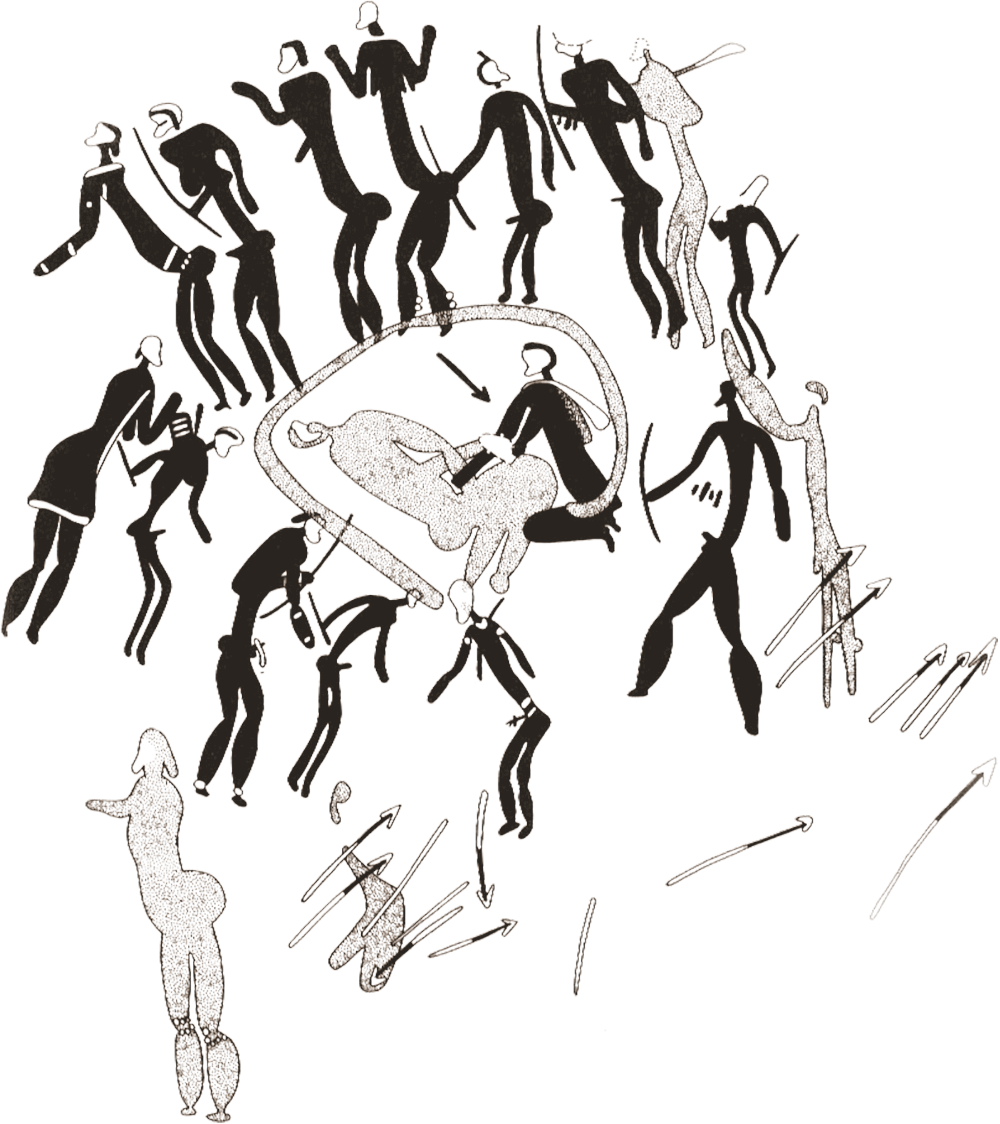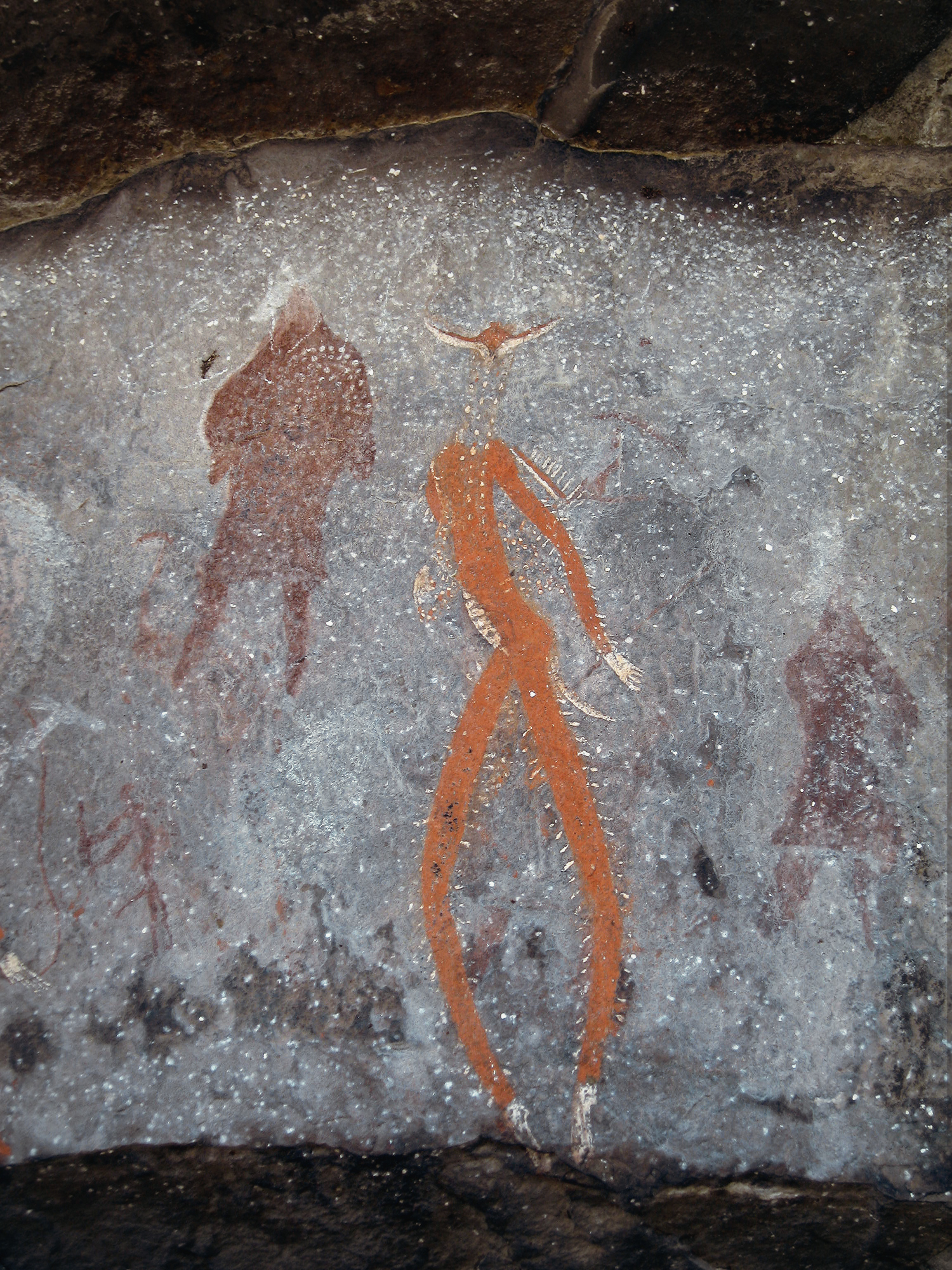This pancocojams post presents an excerpt of a Wikipedia article about the San people of Southern Africa.
This post also presents an excerpt of a bradshaw foundation article about San traditional healing dances as shown in their rock art.
The portion about the San healing dances is presented along with my question about whether those dances are a source (or the main source) for the circular, spinning dances that are done by members of many Southern Africa's Zionist Christian churches.
The content of this post is presented for historical, religious, and cultural purposes.
All copyrights remain with their owners.
Thanks to all those who are quoted in this post. Thanks also to the publisher of the video on YouTube that is embedded in this post.
-snip-
This pancocojams post is part of an ongoing pancocojams series about religion in Africa.
****
DISCLAIMER
I'm an African American who knows very little about any Black cultures (or any other cultures) outside of the United States. However, I'm very interested in learning about other cultures, particularly about Black cultures throughout the world.
In 2016 I happened to come across YouTube videos of Southern African Zionist Christian church members walking and spinning in circles. Click http://pancocojams.blogspot.com/2016/02/south-african-isikhalanga-wafa-wafa.html for a 2016 pancocojams post that showcases YouTube videos of those dances (One of those videos is of a church in the United Kingdom which presumably was started by people of Southern African descent. Some of those videos use the words "Wafa wafa" in their title while some other titles for these videos include the word "isikhalanga". I think that word is used as a referent for those circular religious dances.
Here's a statement that I wrote in that 2016 pancocojams post:
" The isikhalanga circular movement is somewhat similar to the 19th century (if not older) African American religious shouts. However, the videos of depictions of shouts that I've watched don't include the individual spinning that appears to be one of the key signatures of isikhalanga. That isikhalanga spinning movement reminds a little of the Sufi "whirling dervishes". That spinning also reminds me of the spinning movements of some traditional Igbo Nigerian masqueraders. This South African spinning movement also reminds me of the "wheel and turn" movements in Jamaican Kumina dancing."
My interest in these religious dances was recently revived when I again happened upon some YouTube videos of Southern African Zionists and my online search for information about those dances led me to the article about San healing dances that is included in this 2022 pancocojams post.
Spepa (Jimila kubekwa ilitshe likamkhululi.
Trevor Ncube Oct 3, 2018
I sincerely apologize for my ignorance about these subjects and I mean no disrespect with my inquiries about the sources for these Zionist dances, their referents, and their religious and cultural meanings.
I would greatly appreciate any information and corrections about these subjects.
****
ARTICLE EXCERPT ABOUT THE SAN PEOPLE
From https://en.wikipedia.org/wiki/San_people
The San peoples (also Saan), or Bushmen,[1] are members of
various Khoe, Tuu, or Kxʼa-speaking indigenous hunter-gatherer cultures that
are the first cultures of Southern Africa, and whose territories span Botswana,
Namibia, Angola, Zambia, Zimbabwe, Lesotho[2] and South Africa. In 2017,
Botswana was home to approximately 63,500 San people, which is roughly 2.8% of
the country's population, making it the country with the highest population of
San people.[3]
[…]
Names
The endonyms used by San themselves refer to their
individual nations, including the ǃKung (ǃXuun) (subdivisions ǂKxʼaoǁʼae
(Auen), Juǀʼhoan, etc.) the Tuu (subdivisions ǀXam, Nusan (Nǀu), ǂKhomani,
etc.) and Tshu–Khwe groups such as the Khwe (Khoi, Kxoe), Haiǁom, Naro, Tsoa,
Gǁana (Gana) and Gǀui (ǀGwi).[12][13][14][15][16] Representatives of San
peoples in 2003 stated their preference of the use of such individual group
names where possible over the use of the collective term San.[17]
Both designations "Bushmen" and "San" are exonyms in origin, but San had been widely adopted as an endonym by the late 1990s. "San" originates as a pejorative Khoekhoe appellation for foragers without cattle or other wealth, from a root saa "picking up from the ground" + plural -n in the Haiǁom dialect.[18][19] The term Bushmen, from 17th-century Dutch Bosjesmans, is still widely used by others and to self-identify, but in some instances the term has also been described as pejorative.[14][20][21][22]
Adoption of the Khoekhoe term San in Western anthropology dates to the 1970s, and this remains the standard term in English-language ethnographic literature, although some authors have later switched back to Bushmen.[4][23] The compound Khoisan, used to refer to the pastoralist Khoi and the foraging San collectively, was coined by Leonhard Schulze in the 1920s and popularised by Isaac Schapera in 1930, and anthropological use of San was detached from the compound Khoisan,[24] as it has been reported that the exonym San is perceived as a pejorative in parts of the central Kalahari.[20] By the late 1990s, the term San was in general use by the people themselves.[25] The adoption of the term was preceded by a number of meetings held in the 1990s where delegates debated on the adoption of a collective term.[26] These meetings included the Common Access to Development Conference organised by the Government of Botswana held in Gaborone in 1993,[15] the 1996 inaugural Annual General Meeting of the Working Group of Indigenous Minorities in Southern Africa (WIMSA) held in Namibia,[27] and a 1997 conference in Cape Town on "Khoisan Identities and Cultural Heritage" organised by the University of the Western Cape.[28] The term San is now standard in South African, and used officially in the blazon of the national coat-of-arms. The "South African San Council" representing San communities in South Africa was established as part of WIMSA in 2001.[29][30] "Bushmen" is now considered derogatory by many South Africans,[20][22][31] to the point where, in 2008, use of boesman (the modern Afrikaans equivalent of "Bushman") in the Die Burger newspaper was brought before the Equality Court, which however ruled that the mere use of the term cannot be taken as derogatory, after the San Council had testified that it had no objection to its use in a positive context.[32]
In Angola they are sometimes referred to as mucancalas,[38]
or bosquímanos (a Portuguese adaptation of the Dutch term for
"Bushmen"). The terms Amasili and Batwa are sometimes
used for them in Zimbabwe.[28] The San are also referred to as Batwa by
Xhosa people and Baroa by Sotho people.[39] The Bantu term Batwa
refers to any foraging tribesmen and as such overlaps with the terminology used
for the "Pygmoid" Southern Twa of South-Central Africa."...
****
ARTICLE EXCERPT ABOUT SAN'S TRADITIONAL HEALING DANCES
From https://www.bradshawfoundation.com/south_africa/san_rock_art/index.php The Eland in San Rock Art Paintings
"The most important San ritual was the healing or trance dance. These dances continue to be practised amongst San groups living in the Kalahari today. Dancers stomp in a circle around the campfire for many hours. The women clap the rhythm of the dance and sing powerful songs. After hours of stomping, some dancers start to slip into trance. In this altered state of consciousness they may have out-of-body experiences. They describe travelling to the spirit realm.
The healing dance performed by San shamans to find and cast out sickness starts at night and carries on until dawn the next day. As well as living dancers, it was believed that the dancers were also attended by grotesque spirits of the dead.
The dance starts with a few women singing snatches of songs that are different from ordinary recreational songs. These special medicine songs contain n/om, a supernatural potency that permeates the cosmos but that resides particularly in large animals, such as giraffe and eland, and in the shamans themselves. Some San paintings are part human - part animal; these creatures are known as therianthropes, depicting dancers/shamans who have taken on the potency of a particular animal.
Soon the men start dancing around the women who have seated themselves in a tight circle around a central fire. The shamans push themselves towards an altered state of consciousness; they enter 'half-death'. They attain ecstasy simply by means of their dancing, concentration and hyperventilation, with the help of the women's insistent and rhythmic singing and clapping.
In half-death the shamans battle with malevolent spirits of the dead, who come to the dance and try to shoot small, invisible, 'arrows-of-sickness' into people. Attracted by the beautiful singing and dancing, the spirits lurk in the African night beyond the small circle of firelight. Balanced precariously on the edge of oblivion, experienced shamans move from person to person, laying hands on them and drawing known and unknown ills out of them. Then with a high-pitched cry they cast sickness and strife back into the darkness whence they came.

Sometimes, at the height of the dance, when the atmosphere is charged with n/om and the world is beginning to spin, some of the shamans fall unconscious in trance, sometimes casting themselves headlong into the fire. Their spirits have left their bodies on a dangerous, frightening and painful mission to protect their people. The most powerful shamans reach the terrifying abode of god himself, and there they remonstrate with him, pleading for the lives of any who may be critically ill.
People care for shamans who have entered trance, rubbing them with sweat and flicking them with flywhisks to deflect approaching arrows-of-sickness. Later, the unconsciousness of deep trance fades into natural sleep and the dance breaks up. In the morning, life goes on - cleansed - and the people, united by the great cathartic experience of the dance, return to the real life world of hunting and gathering.
Dying eland are common in San rock art. The explanation for this lies in the fact that the San word for dying is the same as the San word for entering deep trance. Many San painters depicted dying eland in close association with 'dying' dancers. The experiences of trembling, sweating and bleeding from the nose before finally collapsing were common to both; beyond this the eland was the supreme source of the potency sought by San dancers. The San describe their experiences of out-of-body travel as like flying."...
-end of excerpt-
Notice that the dancers depicted in that second San Rock art drawing are moving counterclockwise.
In many of the YouTube videos of Southern African Zionist circle dances/spinning the people are also moving counterclockwise.
****
Thanks for visiting pancocojams.
Visitor comments are welcome.

My name is Sibusiso Zondo from SA Pretoria and I've been attending the Zion Church since I was Born. I must say, I have leaned a lot from the reference u have attached about the History of isikhalanga more especially in relation to the San people of SA, however from the knowledge that I have about isikhalanga thus far, Isikhalanga is not a traditional dance in Africa hence if you make your research you will realize that it not practiced in both cultural and traditional way to connect to spirits, except for in church were Zion people who are engaging in it are claiming to be using it as a form of prayer and to connect with God, and you can trace this type of Zion prayer from Zimbabwe, Malawi, Mozambique, Botswana, Swaziland and and South Africa my observation however is that traditional healers enjoy attending isikhalanga prayers but their (Ubungoma, Ukuthwasa) traditional dances are totally different from isikhalanga spinning prayer and I will be honest up to this day, many people are also claiming that isikhalanga spinning dance commenced in Zimbabwe from the tribe called Amakhalanga and I am not sure either they engaged in this dance for cultural, traditional purposes or religious purposes.
ReplyDeleteHello, Sibusisi Zondo. Thank you for your comment. What you wrote is exactly the type of cultural sharing that I hoped that this article would result in. Unfortunately. there is very little about South Africa's Zion church and the Isikhalanga dance online.
DeleteYour comment based on your life experiences adds to this information. I appreciate it very much.